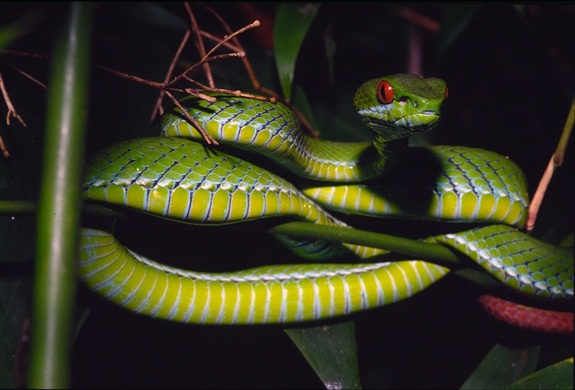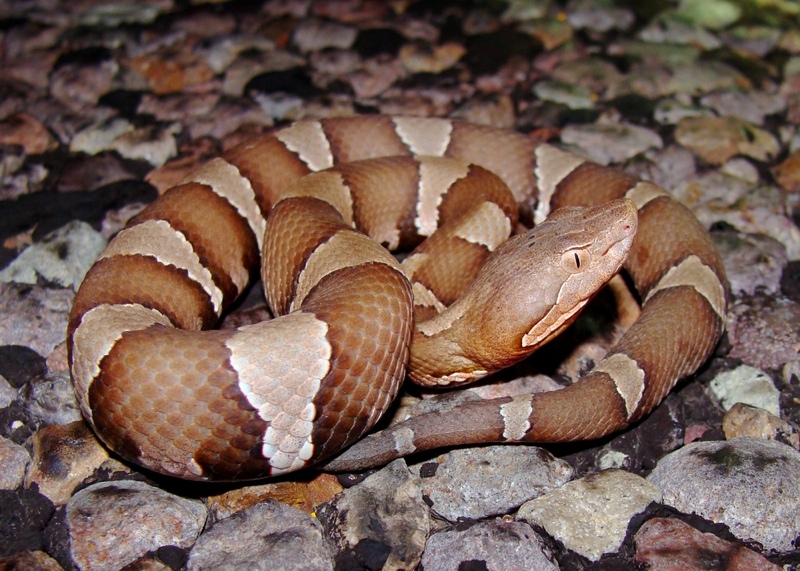Facts About Vipers

Vipers are a large family of snakes; the scientific name is Viperidae. They are found all over the world, with the exceptions of Antarctica, Australia, New Zealand, Madagascar, north of the Arctic Circle and island clusters such as Hawaii.
The family Viperidae includes adders, pit vipers (like rattlesnakes, cottonmouths and copperheads), the Gaboon viper, green vipers and horned vipers.
All vipers are venomous and have long, hinged fangs. "Generally more venomous vipers are in tropical areas, particularly South America and Africa," said Alan Savitzky, a professor of biological sciences at Utah State University specializing in the biology of snakes. Vipers found in colder, northern climates, such as the black or European adder have more moderate venom.
[Image gallery: Snakes of the World]
Physical characteristics
Vipers range widely in size, though are generally stocky with short tails. One of the world’s smallest vipers is the Mao-Lan pit viper (Protobothrops maolanensis), which was discovered in China in 2011. They are less than 2 feet (61 centimeters) long, according to National Geographic. The longest viper — and the longest venomous snake in the Americas — is the South American Bushmaster (Lachesis muta), which grows to more than 11 feet (335 cm), according to the University of Michigan’s Animal Diversity Web (ADW).
Almost all vipers have a distinctive triangular head, according to Discover magazine. This head shape is due to the placement of their large venom glands in the mouth. Some nonvenomous species have evolved a similarly shaped head in order to potentially trick predators into thinking they are vipers. Additionally, most vipers have keeled scales, vertically elliptical pupils and coloring and patterns that serve as camouflage.
Fangs
Vipers are known for their extreme fangs, which are long, hollow, hinged and rotatable, according to an article in the journal Physiological and Biochemical Zoology. These fangs connect to venom glands located behind the eyes at the back upper part of the jaw. Venom travels down through the follow teeth to be injected into prey as the viper bites.
Vipers can rotate their fangs together or independently, which allows them to wait until the last second to erect their fangs. Their mouths can open nearly 180 degrees so the ability to rotate their fangs within that space is an advantage. When not in use, vipers’ hinged fangs fold up and lie against the roof of the snake’s mouth. This allows their fangs to grow relatively long, according to Andrew Solway, author of "Deadly Snakes" (Heinemann-Raintree, 2005).
Vipers can extend their fangs and bite without injecting venom. This is known as a dry bite and is common in human snakebites. Dry bites enable vipers to conserve their previous venom, which can run out and takes a while to replenish, according to an article in the journal Tropical and Geographical Medicine.
Habitat
Vipers' habitats vary across their nearly worldwide range. They live in mountains, rainforests, fields and deserts.
Behavioral, hunting and feeding habits
Generally, vipers are nocturnal. They often appear sluggish compared to other snakes, according to Nicolae Sfetcu, author of "Reptiles: Crocodiles, Alligators, Lizards, Snakes, Turtles" (Lulu Press, 2011). This is because many vipers rely on their camouflage for protection rather than their ability to move quickly. They are more inclined to blend in with the surrounding brush, rocks or ground cover when being approached by a predator than to slither away.
Nevertheless, vipers have a speedy strike. For example, Africa's puff adder can strike at a speed of a quarter of a second, according to Perry's Bridge Reptile Park in South Africa.
Their perceived sluggishness impacts their hunting tactics. "Most vipers are ambush predators," said Savitzky. "They detect where prey is most likely to be chemically and just wait. Because they're not expending a lot of energy, low resting metabolic rate, and eat large things, they can afford to do that."
Vipers eat a variety of food depending on the size of the snake. Prey includes small mammals, birds, lizards and eggs, according to Savitzky. When their prey is dead, they swallow it whole.
Vipers engage in a hunting activity called prey relocation, according to an article in BMC Biology journal. This means that once they have identified their prey, they strike it and inject venom. They then immediately release the prey so that it cannot bite back. The bitten prey wanders off, dies and the viper uses its sense of smell to find it.
Bite
The severity of a viper bite depends on the species and if it was a wet or dry bite, which contains no venom. Savitzky pointed out that European vipers (adders) have relatively moderate venom that is not highly lethal, while Gaboon vipers, which are found in sub-Saharan Africa, have highly potent venom.
"Vipers in general tend to have enzymetic venom that affects general tissues," Savitzky said. It causes intense swelling, pain and necrosis, which is cell death and decay. It also functions as an anticoagulant. Death usually occurs from a dramatic collapse in blood pressure. All viper bites should be treated seriously and medical attention should be paid.
In addition to killing prey and injuring predators, viper venom helps vipers digest their food, according to Sfetcu. Since they swallow their prey whole, digesting it is a big job not helped by vipers' generally inefficient digestive systems. The venom breaks down lipids, acids and proteins in the prey during the digestive process.
Reproduction
Most vipers are ovoviviparous, Savitzky said. That means the eggs are fertilized and incubate inside the mother and she gives birth to live young. "But," he added, "That is not true of some basal Asian pit vipers. And all New World pit vipers but one have live birth. That one is the Bushmaster viper and it has re-evolved egg laying."
Vipers' mating season, activities and egg incubation time depends on the species.
Taxonomy/classification
According to the Integrated Taxonomic Information System (ITIS), there are more than 200 species of viper. The taxonomy of vipers is:
Kingdom: Animalia Subkingdom: Bilateria Infrakingdom: Deuterostomia Phylum: Chordata Subphylum: Vertebrata Infraphylum: Gnathostomata Superclass: Tetrapoda Class: Reptilia Order: Squamata Suborder: Serpentes Infraorder: Alethinophidia Family: Viperidae Subfamilies:
- Azemiopinae (1 genus — Azemiops)
- Causinae (1 genus — Causus)
- Crotalinae (pit vipers; 18 genera)
- Viperinae (12 genera)
Types of vipers
The following are descriptions of some particularly fascinating vipers.
Gaboon viper (Bitis gabonica)
Gaboon vipers are the largest vipers in the world, reaching lengths of up to 7 feet (213 cm) and more than 22 lbs. (10 kilograms), according to the ADW. Females are significantly longer than males. Though the South American Bushmaster is longer, the Gaboon viper is heavier. Savitzky noted that Gaboon vipers are of the adder lineage, so referring to them as Gaboon adders is also correct. They live throughout sub-Saharan Africa in rainforests and other tropical areas. They spend most of their time lying in wait among leaf litter.
Gaboon vipers' real claims to fame are their extraordinary long fangs — the longest of any snake, said Savitzky. Gaboon vipers' fangs can be up to 2 inches (5 cm) long. They also have potent venom. They mostly eat small mammals, birds and amphibians, but have been recorded eating small antelopes and giant rats, according to the ADW.
Pit vipers
Pit vipers are a subfamily (Crotalinae) of vipers. There are about 190 species, according to ITIS. Pit vipers are found throughout the Americas, Europe and Asia. All vipers in the Americas are pit vipers, according to The University of Pittsburgh. "Pit vipers apparently have their basal species in Asia and then a lot of radiation in the New World," said Savitzky.
"They are all distinguished by the presence of the pit organ on either side of the face," he continued. "These are infrared receptors. They detect heat energy. Pit vipers see the world in a combination of heat and light. The receptors detect warm blooded prey but also can detect cold blooded prey, though they're more responsive to warm."
Some species of pit vipers include rattlesnakes, cottonmouths, copperheads, lanceheads and bushmasters.
Green vipers
Several types of snakes are referred to as green vipers due to their coloring. They include the Chinese green viper (Trimeresurus stejnegeri), the green night adder (Causus resimus), the Great Lakes bush viper (Atheris nitschei) and the newly discovered ruby-eyed green pit viper (Cryptelytrops rubeus). These are all Old World snakes, found in Africa and Asia.
Probably the most famous of the green vipers is Trimeresurus albolabris, also called green pit viper or white-lipped viper. They are found in Southeast Asia, India and southern China, according to The University of Adelaide's Clinical Toxinology Resources. These vibrant vipers are a bright Kelly green and have vivid yellow eyes. Their jaws are white or yellow, presumably giving rise to their white-lipped name. Males have a narrow white stripe running down the sides of their bodies.

Horned vipers
Several types of snakes are referred to as horned vipers due to the presence of horn-shaped scales on their faces. They include the Saharan horned viper or desert horned viper (Cerastes cerastes), the Arabian horned viper or Middle Eastern horned viper (Cerastes gasperettii), the horned puff adder (Bitis caudalis) and the nose-horned viper (Vipera ammodytes), which has a horn at the top of its nose. The other species have a horn over each eye.
All horned vipers live in Africa and the Middle East but the nose-horned viper, which are found in Europe and Asia. A new species, named Matilda's horned viper (Atheris matildae) was discovered in Tanzania in 2012. [Photos: Vivid Images of New Snake Species]
The horns are made of single or multiple scales, depending on the species, according to the ADW. Not all horned vipers have horns; sometimes the same clutch of eggs will yield animals with and without horns. The horns can bend back to be flat against the head, which is useful when the snake is going down a burrow.
The purpose of horns is uncertain. Some scientists speculate that horns break up the outline of the animal, making it more difficult for predators to see. Others speculate that the horns may help protect the snake's eyes from sand in some way. This would explain why snakes with horns over their eyes are found in deserts.
Eyelash pit viper (Bothriechis schlegelii)
Called both the eyelash pit viper and eyelash palm pit viper, these small snakes are found in Central America and northern South America. They are named for the bristly scales above their eyes, which resemble eyelashes or hoods. They are also distinguishable by their bright coloration and appear in vibrant yellows or greens (the most common coloration), pinks, purples, silver, dark gray or brown, according to the ADW. Their coloring is camouflage and allows them to blend in with banana bunches or flowers.
They average around 2 feet (61 cm) in length and are one of the smallest poisonous snakes in their range. They are largely arboreal.
The purpose of the eyelashes is unknown, according to the ADW. Some scientists have suggested they protect the vipers' eyes as they move through thick vegetation.
Endangerment status
According to the International Union for Conservation of Nature (IUCN), 57 species of viper are considered near threatened, conservation-dependent, vulnerable, endangered or critically endangered, extinct or extinct in the wild. Some of the rarest vipers are the golden lancehead (Bothrops insularis), which is found only on a small island off the coast of Brazil, and the Santa Catalina rattlesnake, which is found only on Santa Catalina Island in the Gulf of California in Mexico. According to IUCN, this snake has declined principally due to overcollecting.
Additional resources
Sign up for the Live Science daily newsletter now
Get the world’s most fascinating discoveries delivered straight to your inbox.
Jessie Szalay is a contributing writer to FSR Magazine. Prior to writing for Live Science, she was an editor at Living Social. She holds an MFA in nonfiction writing from George Mason University and a bachelor's degree in sociology from Kenyon College.










